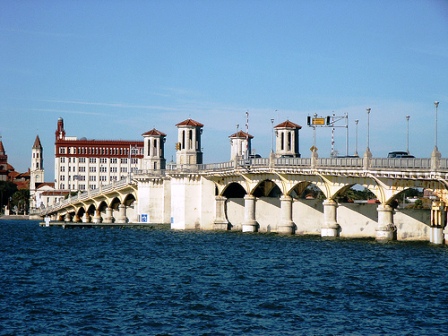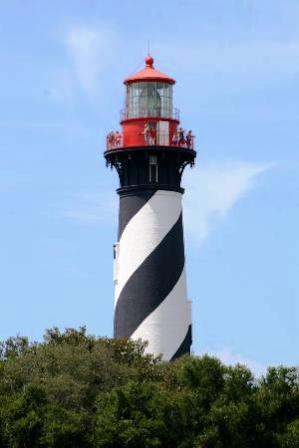Discover Florida Nature
It's time to explore the natural Florida


|
|
|
|
|
 St.
Augustine is the county seat of St. Johns County, Florida. Founded in
1565, it is the oldest continuously occupied European established city,
and the oldest port, in the continental United States. St. Augustine
lies in a region of Florida known as The First Coast, which extends from
Amelia Island in the north, south
to Jacksonville, St. Augustine and Palm Coast. Come to St. Augustine,
Ponte Vedra and the Beaches for a Florida getaway unlike any other.
Here, brick streets lead to historic churches, living history museums,
antiques stores, charming restaurants and B&Bs, and shops. A
centuries-old fort stands guard, horse-drawn carriages clip-clop through
the historic district, and ghost tours show you the area’s secrets. This
St. Johns County city boasts a plethora of historically significant
structures, perhaps none as famous as Castillo de San Marcos, built
between 1672 and 1695. St.
Augustine is the county seat of St. Johns County, Florida. Founded in
1565, it is the oldest continuously occupied European established city,
and the oldest port, in the continental United States. St. Augustine
lies in a region of Florida known as The First Coast, which extends from
Amelia Island in the north, south
to Jacksonville, St. Augustine and Palm Coast. Come to St. Augustine,
Ponte Vedra and the Beaches for a Florida getaway unlike any other.
Here, brick streets lead to historic churches, living history museums,
antiques stores, charming restaurants and B&Bs, and shops. A
centuries-old fort stands guard, horse-drawn carriages clip-clop through
the historic district, and ghost tours show you the area’s secrets. This
St. Johns County city boasts a plethora of historically significant
structures, perhaps none as famous as Castillo de San Marcos, built
between 1672 and 1695.The Castillo de San Marcos is considered by many to be the most impressive of all the historical sites in St. Augustine. Many thousands of people come each year to view the imposing fortress and to learn about the fascinating years that it served the city. Constructed of coquina stone that was shipped in from Anastasia Island, the Castillo is the oldest remaining European fort in the United States. It was built to protect and defend the city of St. Augustine which belonged to the Spanish at the time. Later, the structure was used for various reasons including holding Indian prisoners during the Seminole Wars and Confederate soldiers during the Civil War. A tour of the bastion allows visitors to see the walls that withstood many battles of colonial warfare and to witness the ways in which it protected the city. The Bridge of Lions is a bascule bridge that spans the Intracoastal Waterway in St. Augustine, Florida. A part of State Road A1A, it connects downtown St. Augustine to Anastasia Island. Lions made of marble used to guard the bridge, begun in 1925 and completed in 1927 across Matanzas Bay. The lions were removed in February 2005, and are expected to return about five years from that date.  More
than 300 years ago, sites like the coquina quarries located within
Anastasia State Recreation Area were busy with workmen, mostly Native
Americans, hauling out blocks of rock. By the late 1700’s, the Native
American population had died out and quarry workers were usually
enslaved Africans. With hand tools, they hewed out blocks of the soft
shellstone and pried the squares loose along natural layers in the rock.
The blocks were loaded onto ox-drawn carts, then barged across Matanzas
Bay to the town of St. Augustine. The blocks were used to construct the
Castillo de San Marcos and many other public and private buildings. More
than 300 years ago, sites like the coquina quarries located within
Anastasia State Recreation Area were busy with workmen, mostly Native
Americans, hauling out blocks of rock. By the late 1700’s, the Native
American population had died out and quarry workers were usually
enslaved Africans. With hand tools, they hewed out blocks of the soft
shellstone and pried the squares loose along natural layers in the rock.
The blocks were loaded onto ox-drawn carts, then barged across Matanzas
Bay to the town of St. Augustine. The blocks were used to construct the
Castillo de San Marcos and many other public and private buildings.Anastasia State Park welcomes hundreds of thousands visitors from all over the world to enjoy our natural and cultural treasures. At Anastasia you can enjoy camping, nature trails, beach time, water sports, and an archaeological site where coquina rock was mined to create the nearby fortress, Castillo de San Marcos National Monument. Anastasia State Park, located just south of historic St. Augustine on Anastasia Island, has 4 miles of pristine beach, a tidal salt marsh, and maritime and upland hammock. Camping, beachcombing, swimming, fishing, picnicking, windsurfing, hiking, wildlife-viewing, canoeing and kayaking are popular activities. Nature trails meander through the ancient dunes shaded by hammock forest. The full-facility campground is located in a wooded area within easy bicycling or walking distance of the beach. The Atlantic Ocean bordering St. Augustine has been a challenge for mariners dating all the way back to its founding in 1565. The current St. Augustine Lighthouse was completed in 1874 and is still an active aid to navigation today! In this video, climb the lighthouse, explore St. Augustine's maritime museum, and learn about the importance of this beacon in the history of the United States' oldest port city. History buffs will adore the many museums in the area. The Lightner Museum is among the most unique, featuring an intriguing array of items, from shrunken heads and mummies to stunning collections of stained glass and crystal. When it opened its doors in 1889, Henry Flagler's Alcazar Hotel delighted guests with its gigantic indoor pool and retractable roof, casino, spa, and movie theater. O.C. Lightner jumped at the opportunity to live in the hotel when it became available for purchase and house his unique collections here. |
|
|
St Augustine Florida
St. Augustine lies in a region of Florida known as The First Coast, which extends from Amelia Island in the north, south to Jacksonville, St. Augustine and Palm Coast. Come to St. Augustine, Ponte Vedra and the Beaches for a Florida getaway unlike any other. Here, brick streets lead to historic churches, living history museums, antiques stores, charming restaurants and B and Bs, and shops. A centuries-old fort stands guard, horse-drawn carriages clip-clop through the historic district, and ghost tours show you the area’s secrets. This St. Johns County city boasts a plethora of historically significant structures, perhaps none as famous as Castillo de San Marcos, built between 1672 and 1695.
St. Augustine is the oldest city in the United States and is a top destination for those who appreciate Floridian nature. A personal favorite, I always enjoy a peaceful weekend in St. Augustine and have visited the area dozens of times. I strongly recommend staying in one of the Bed and Breakfast Inns located in the historic district. My personal favorite is the Carriage Way Bed and Breakfast! Be sure to take a boat cruise around the bay and enjoy seeing dolphins follow the boat!
Written by: Floridian Nature
St Augustine
Date published: 10/23/2013
5 / 5 stars
|
|